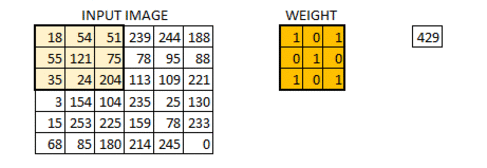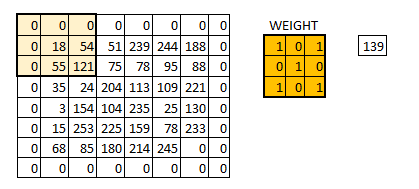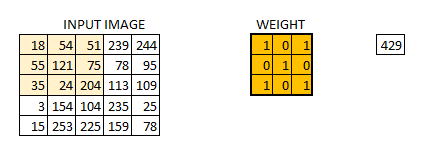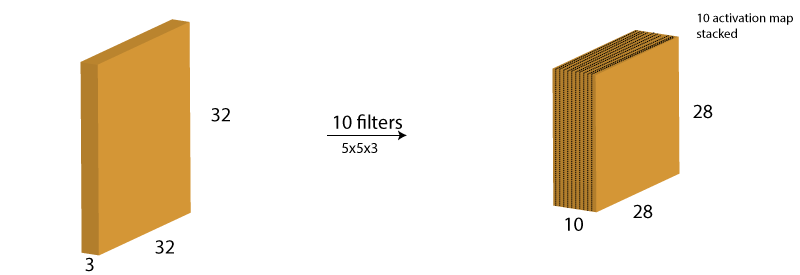1. 卷积神经网络的结构

其中,input为输入,conv为卷积层,由卷积核构成,pool为池层,由池化函数构成最后是全连接层与输出层,其负责对卷积层提取的特征进行处理以获得我们需要的结果
2. 卷积函数
卷积函数是本篇文章要讲解的内容,在TensorFlow中卷积函数输入的参数其输入参数
主要有input, filter, strides, padding, use_cudnn_on_gpu=None,data_format=None, name=None)
其中
1. input 为输入,一个张量Tensor ,数据类型必须为float32 或者 float64
2. filter 为卷积核,输入类型必须与input一样
3. padding为一个字符串取值 SAME为补零使输入输出的图像大小相同,取值VALLD则允许输入输出的图像大小不一致
4. name,可选,字符串,用于可视化中,为该操作起一个名字
5. strides 是另外一个极其重要的参数,其为一个长度为4 的一维整数类型数组,每一位对应input中每一位对应的移动步长
2.1 Input
Input的张量维度:[batch,in_height,in_width,in_channels],例如mnist中的输入图像为 28 * 28 的黑白图像,其张量即为[batch,28,28,1],1代表黑白,RGB彩色图像的通道则为3,而batch 则为输入的图像数量,一次输入10张图片时,其为10,20张时则为20
2.2 filter 卷积核
filter 即为CNN中的卷积核,以我们最常用的tf.nn.conv2d为例 .它要求是一个Tensor,具有[filter_height, filter_width, in_channels, out_channels]这样的shape,(其他的卷积函数其Tensor的具体内容是不一样的,在使用时请注意他们的不同)
tf.nn.conv2d中[filter_height, filter_width, in_channels, out_channels] 含义为[卷积核的高度,卷积核的宽度,图像通道数,卷积核个数],要求类型与参数input相同,有一个地方需要注意,第三维in_channels,就是参数input的第四维.
在使用中,因为一般不对Input的第一维和第四维进行卷积操作,所以strides 一般为[1,X,X,1]
2.3 strides
正如前面所述,strides 是另外一个极其重要的参数,其为一个长度为4 的一维整数类型数组,每一位对应input中每一位对应的移动步长.
步长为一的卷积操作,不补零: 
步长为二的卷积操作,不补零:
2.4 padding 与步长
padding=’SAME’ 时,TensorFlow会自动对原图像进行补零,从而使输入输出的图像大小一致
效果如下: 
padding=’VALLLD’ 时,则会缩小原图像的大小.
3. 输入输出图像大小的计算
此段内容引自我翻译的一篇文章
上面的内容可能会使你混淆每一层的输出尺寸。 所以我决定使用下面的内容让你能够识别输出尺寸。 在卷积层中,有三个关键控制着输出尺寸的大小:
过滤器的数量 ——输出音量的深度就等于滤波器应用的数量。 每个滤波器(卷积核)可以输出一个图片,卷积核增加,输出图片的数量增加
步长 ——控制着卷积核向下移动的像素值。 高步值长时我们跨过的像素值,因此产生较小的输出量。
补零 ——这有助于我们保持输入图像的大小。 如果只在原始图像周围添加一个补零的层数,并且步长为一,那么输出将保留原始图像的大小。
我们可以应用一个简单的公式来计算输出尺寸。 输出图像的空间大小可以计算(W-F + 2 p / S)+ 1。 这里,W是输入图片大小,F是卷积核的大小,P是填充应用的数量和S是步长的数量。
假设我们有一个输入图像的大小32 * 32 * 3,我们应用10过滤器的大小3 * 3 * 3,与单步和补零。W = 32,F = 3,P = 0和S = 1。 输出深度等于过滤器应用的数量即10。输出音量的大小将(32-3 + 0)/ 1 + 1 = 30。 因此,输出音量将30 * 30 * 10。
5. TensorFlow中常用的卷积函数
5.1 tf.nn.conv2d
tf.nn.conv2d:对一个思维的输入数据 input 和四维的卷积核filter 进行操作,然后对输入的数据进行二维的卷积操作,得到卷积之后的结果,也是我们最常用的卷积函数
示例代码:
input_data = tf.Variable(np.random.rand(10, 9, 9, 3), dtype=np.float32)
filter_data = tf.Variable(np.random.rand(2, 2, 3, 2), dtype=np.float32)
y = tf.nn.conv2d(input_data, filter_data, strides=[1, 1, 1, 1], padding='SAME')
print('tf.nn.conv2d : ', y)
# tf.nn.conv2d : Tensor("Conv2D:0", shape=(10, 9, 9, 2), dtype=float32)
# 在padding='SAME'时输入输出的图像大小是一致的5.2 tf.nn.depthwise_conv2d
input 的数据维度 [batch ,in_height,in_wight,in_channels]
卷积核的维度是 [filter_height,filter_heught,in_channel,channel_multiplierl]
将不同的卷积核独立地应用在in_channels 的每一个通道上(用 卷积核1 到卷积核channel_multiplier)
然后将所有结果进行汇总,输出通道的总数是,in_channel * channel_multiplier
代码如下:
input_data = tf.Variable(np.random.rand(10, 9, 9, 3), dtype=np.float32)
filter_data = tf.Variable(np.random.rand(2, 2, 3, 2), dtype=np.float32)
y = tf.nn.depthwise_conv2d(input_data, filter_data, strides=[1, 1, 1, 1], padding='SAME')
print('tf.nn.depthwise_conv2d : ', y)
# tf.nn.depthwise_conv2d : Tensor("depthwise:0", shape=(10, 9, 9, 6), dtype=float32)
# 输出的通道数增加了其效果类似于多个卷积核运算都是张量的一个维度增加,不同之处在于通道数的增加是卷积核在不同通道上运算的结果,而多个卷积核运算是batch的数量增加
6. 完整的示例CODE
# - * - coding: utf - 8 -*-
import tensorflow as tf
import os
import numpy as np
os.environ['TF_CPP_MIN_LOG_LEVEL'] = '2'
# tf.nn.convolution
# 计算N维卷积的和
input_data = tf.Variable(np.random.rand(10, 9, 9, 3), dtype=np.float32)
filter_data = tf.Variable(np.random.rand(2, 2, 3, 2), dtype=np.float32)
y = tf.nn.convolution(input_data, filter_data, strides=[1, 1], padding='SAME')
print('1. tf.nn.convolution : ', y)
# 1. tf.nn.convolution : Tensor("convolution:0", shape=(10, 9, 9, 2), dtype=float32)
# tf.nn.conv2d
# 对一个思维的输入数据 input 和四维的卷积核filter 进行操作,然后对输入的数据进行二维的卷积操作,得到卷积之后的结果
input_data = tf.Variable(np.random.rand(10, 9, 9, 3), dtype=np.float32)
filter_data = tf.Variable(np.random.rand(2, 2, 3, 2), dtype=np.float32)
y = tf.nn.conv2d(input_data, filter_data, strides=[1, 1, 1, 1], padding='SAME')
print('2. tf.nn.conv2d : ', y)
#2. tf.nn.conv2d : Tensor("Conv2D:0", shape=(10, 9, 9, 2), dtype=float32)
# tf.nn.depthwise_conv2d
# input 的数据维度 [batch ,in_height,in_wight,in_channels]
# 卷积核的维度是 [filter_height,filter_heught,in_channel,channel_multiplierl]
# 讲不通的卷积和独立的应用在in_channels 的每一个通道上(从通道 1 到通道channel_multiplier)
# 然后将所有结果进行汇总,输出通道的总数是,in_channel * channel_multiplier
input_data = tf.Variable(np.random.rand(10, 9, 9, 3), dtype=np.float32)
filter_data = tf.Variable(np.random.rand(2, 2, 3, 2), dtype=np.float32)
y = tf.nn.depthwise_conv2d(input_data, filter_data, strides=[1, 1, 1, 1], padding='SAME')
print('3. tf.nn.depthwise_conv2d : ', y)
# tf.nn.separable_conv2d
# 利用几个分离的卷积核去做卷积,在该函数中,将应用一个二维的卷积核,在每个通道上,以深度channel_multiplier进行卷积
input_data = tf.Variable(np.random.rand(10, 9, 9, 3), dtype=np.float32)
depthwise_filter = tf.Variable(np.random.rand(2, 2, 3, 5), dtype=np.float32)
poinwise_filter = tf.Variable(np.random.rand(1, 1, 15, 20), dtype=np.float32)
# out_channels >= channel_multiplier * in_channels
y = tf.nn.separable_conv2d(input_data, depthwise_filter=depthwise_filter, pointwise_filter=poinwise_filter,
strides=[1, 1, 1, 1], padding='SAME')
print('4. tf.nn.separable_conv2d : ', y)
# 计算Atrous卷积,又称孔卷积或者扩张卷积
input_data = tf.Variable(np.random.rand(1, 5, 5, 1), dtype=np.float32)
filters = tf.Variable(np.random.rand(3, 3, 1, 1), dtype=np.float32)
y = tf.nn.atrous_conv2d(input_data, filters, 2, padding='SAME')
print('5. tf.nn.atrous_conv2d : ', y)
# 在解卷积网络(deconvolutional network) 中有时被称为'反卷积',但实际上是conv2d的转置,而不是实际的反卷积
x = tf.random_normal(shape=[1, 3, 3, 1])
kernal = tf.random_normal(shape=[2, 2, 3, 1])
y = tf.nn.conv2d_transpose(x, kernal, output_shape=[1, 5, 5, 3], strides=[1, 2, 2, 1], padding='SAME')
print('6. tf.nn.conv2d_transpose : ', y)
# 与二维卷积类似,用来计算给定三维输入和过滤器的情况下的一维卷积.
# 不同的是,它的输入维度为 3,[batch,in_width,in_channels].
# 卷积核的维度也是三维,[filter_height,in_channel,channel_multiplierl]
# stride 是一个正整数,代表一定每一步的步长
input_data = tf.Variable(np.random.rand(1, 5, 1), dtype=np.float32)
filters = tf.Variable(np.random.rand(3, 1, 3), dtype=np.float32)
y = tf.nn.conv1d(input_data, filters, stride=2, padding='SAME')
print('7. tf.nn.conv1d : ', y)
# 与二维卷积类似,用来计算给定五维输入和过滤器的情况下的三维卷积.
# 不同的是,它的输入维度为 5,[batch,in_depth,in_height,in_width,in_channels].
# 卷积核的维度也是三维,[filter_depth,filter_height,in_channel,channel_multiplierl]
# stride 相较二维卷积多了一维,变为[strides_batch,strides_depth,strides_height,strides_width,strides_channel],必须保证strides[0] = strides[4] =1
input_data = tf.Variable(np.random.rand(1, 2, 5, 5, 1), dtype=np.float32)
filters = tf.Variable(np.random.rand(2, 3, 3, 1, 3), dtype=np.float32)
y = tf.nn.conv3d(input_data, filters, strides=[1, 2, 2, 1, 1], padding='SAME')
print('8. tf.nn.conv3d : ', y)
# 与conv2d_transpose 二维反卷积类似
# 在解卷积网络(deconvolutional network) 中有时被称为'反卷积',但实际上是conv3d的转置,而不是实际的反卷积
x = tf.random_normal(shape=[2, 1, 3, 3, 1])
kernal = tf.random_normal(shape=[2, 2, 2, 3, 1])
y = tf.nn.conv3d_transpose(x, kernal, output_shape=[2, 1, 5, 5, 3], strides=[1, 2, 2, 2, 1], padding='SAME')
print('9. tf.nn.conv3d_transpose : ', y)运行结果:
1. tf.nn.convolution : Tensor("convolution:0", shape=(10, 9, 9, 2), dtype=float32)
2. tf.nn.conv2d : Tensor("Conv2D:0", shape=(10, 9, 9, 2), dtype=float32)
3. tf.nn.depthwise_conv2d : Tensor("depthwise:0", shape=(10, 9, 9, 6), dtype=float32)
4. tf.nn.separable_conv2d : Tensor("separable_conv2d:0", shape=(10, 9, 9, 20), dtype=float32)
5. tf.nn.atrous_conv2d : Tensor("convolution_1/BatchToSpaceND:0", shape=(1, 5, 5, 1), dtype=float32)
6. tf.nn.conv2d_transpose : Tensor("conv2d_transpose:0", shape=(1, 5, 5, 3), dtype=float32)
7. tf.nn.conv1d : Tensor("conv1d/Squeeze:0", shape=(1, 3, 3), dtype=float32)
8. tf.nn.conv3d : Tensor("Conv3D:0", shape=(1, 1, 3, 5, 3), dtype=float32)
9. tf.nn.conv3d_transpose : Tensor("conv3d_transpose:0", shape=(2, 1, 5, 5, 3), dtype=float32)
作者:FontTian
原文链接
共同学习,写下你的评论
评论加载中...
作者其他优质文章







